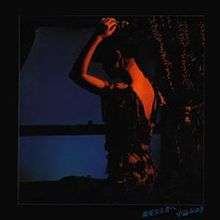Shin'ai Naru Mono e
Shin-ai Naru Mono e (親愛なる者へ) is the fifth studio album by Japanese singer-songwriter Miyuki Nakajima, released in March 1979.
| Shin-ai Naru Mono e | ||||
|---|---|---|---|---|
 | ||||
| Studio album by | ||||
| Released | March 21, 1979 | |||
| Recorded | Epicurus and Take One Studios (Tokyo, Japan) | |||
| Genre | Folk | |||
| Length | 46:24 | |||
| Label | AARD-VARK/Canyon, Yamaha Music Communications | |||
| Producer | Miyuki Nakajima | |||
| Miyuki Nakajima chronology | ||||
| ||||
The album is best known for the track "Ōkami ni Naritai", which has been one of fan favorites and later included on the compilation album Daiginjo released in 1996. It gained another public attention in the late 1990s, through the TV ad for Otsuka Pharmaceutical Co.'s energy drink which features the song.
Shin-ai Naru Mono e was relatively successful upon its release, although there was no lead single before the album came out. It debuted at the number-three on the Oricon LP chart and climbed the summit of there in April 1979, providing her with the first number-one spot on the album chart.
Track listing
All songs written and composed by Miyuki Nakajima
Side one
All tracks arranged by Takahiko Ishikawa (except "Taxi Driver" and "Neyuki" arranged by Shun Fukui)
- "Hadashi de Hashire (裸足で走れ)" - 4:38
- "Taxi Driver (タクシー ドライバー)" - 6:09
- "Doroumi no Naka kara (泥海の中から)" - 3:01
- "What is Hard to Believe (信じ難いもの, Shinjigatai Mono)" - 3:08
- "Neyuki (根雪)" - 6:23
Side two
All tracks arranged by Shun Fukui (except "Koishi no You ni" and "Ōkami ni Naritai" arranged by Takahiko Ishikawa)
- "Kataomoi (片想)" - 2:34
- "Dial 117 (ダイヤル117)" - 4:25
- "Koishi no You ni (小石のように)" - 3:36
- "Ōkami ni Naritai (狼になりたい)" - 5:42
- "Dangai —Shin-ai Naru Mono e (断崖—親愛なる者へ)" - 6:48
Personnel
- Miyuki Nakajima - Lead vocal, acoustic guitar
- Takahiko Ishikawa - Acoustic guitar, banjo
- Kiyoshi Sugimoto - Acoustic guitar
- Shigeru Suzuki - Electric guitar
- Ken Yajima - Electric guitar
- Graham Thumb Picking Power - Electric bass
- Hiro Tsunoda - Drums
- Tatsuo Hayashi - Drums
- Nobu Saito - Percussion
- Pecker - Percussion
- Jake H. Conception - Saxophone
- Shunzo Sunahara - Flute
- Makiko Tashiro - Keyboards
- Kentaro Haneda - Keyboards
Production
- Recording director: Yoshio Okujima
- Recording and mixing engineer: Yoshihiko Kaminari
- Remixing and mixing engineer: Kinji Yoshino
- Assistant engineer: Kouji Sakakibara
- Promoter: Yoshiki Ishikawa
- Manager: Hiroshi Kojima
- Assistant promotional manager: Kunio Kaneko
- Designer: Hirofumi Arai
- Art director: Jin Tamura
- Costume designer: Mihoko Kiyokawa
- Producer: Miyuki Nakajima
- General producer: Genichi Kawakami
Recorded at Epicurus and Take One Studios, special thanks to Kochibi
Chart positions
| Year | Album | Country | Chart | Position | Weeks | Sales |
|---|---|---|---|---|---|---|
| 1979 | Shin-ai Naru Mono e | Japan | Oricon Weekly LP Albums Chart (top 100) | 1 | 48 | 327,000[1] |
| Oricon Weekly CT Albums Chart (top 100) | 7 | 32 | ||||
Release history
| Country | Date | Format | Label | Catalog number |
|---|---|---|---|---|
| Japan | March 21, 1979 | LP | Canyon Records | C25A-0031 |
| Audio cassette | Pony | 25P-7041 | ||
| March 1, 1981 | LP | Canyon Records | C28A-0147 | |
| May 21, 1981 | Audio cassette | Pony | 28P-6070 | |
| December 1, 1983 | CD | Canyon Records | D35A-0027 | |
| November 5, 1986 | D32A-0232 | |||
| March 21, 1989 | Pony Canyon | D35A-0457 | ||
| May 21, 1990 | PCCA-00074 | |||
| April 18, 2001 | Yamaha Music Communications | YCCW-00008 | ||
| October 1, 2008 | YCCW-10057 | |||
References
- "- Yamachan Land (Archives of the Japanese record charts) - Albums Chart Daijiten - Miyuki Nakajima" (in Japanese). December 30, 2007. Archived from a-中島みゆき the original Check
|url=value (help) on June 19, 2007. Retrieved October 25, 2009.